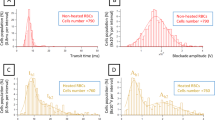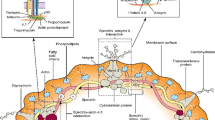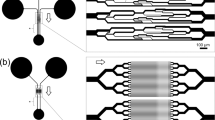Abstract
Low temperature can be expected to increase the resistance to deformation of red blood cells, but the effect of such changes on microcirculatory perfusion are unknown. We therefore analysed resistance to flow through capillary-sized apertures for individual human red blood cells, by micropipette aspiration (approximately 3 μm aperture) and pore transit analysis (approximately 5 μm), as well as average resistance to flow of red cell suspension through multipore filters (5-μm pores). Over a range decreasing from 37 to 0 °C, rates of flow of single cells through the 3- and 5-μm apertures decreased monotonically by 2.5- to 3-fold. The changes were similar in magnitude to that expected for the viscosity of aqueous fluid (2.5-fold increase). Average flow resistance measured by bulk filtration also increased in line with viscosity of water, while tendency to block pores was not increased. Micropipette aspiration of small membrane tongues showed that membrane rigidity increased as temperature was lowered, but by a factor rather less than the viscosity. Cell volume also responded rapidly to change in temperature, with lower temperature being associated with swelling, although this effect was much reduced in plasma compared with saline buffer. We conclude that, although increased resistance to deformation of red cells may impair microcirculation at low temperature, there is no structural change likely to induce more dramatic occlusion of flow. Moreover, the effect is comparable in magnitude to the increase predicted for changes in plasma and blood viscosity.
Similar content being viewed by others
References
Aoshiba K, Nagai A, Konno K (1993) Effects of temperature and pH level on neutrophil filterability. Clin Hemorheol 13: 23–24
Barbee JH (1973) The effect of temperature on the relative viscosity of human blood. Biorheology 10:1–5
Bareford D, Coppock JS, Stone PCW, Bacon PA, Stuart J (1986) Abnormal blood rheology in Raynaud’s phenomenon. Clin Hemorheol 6:53–60
Chien S (1987) Physiological and pathophysiological significance of hemorheology. In: Chien S, Dormandy J, Ernst E, Matrai A (eds) Clinical haemorheology. Martinus Nijhoff, Boston, pp 125–164
Cossins AR, Bowler K (1987) Temperature biology of animals. Chapman and Hall, London
Dintenfass L (1977) Hemorheological factors in Raynaud’s phenomenon. Angiology 28:472–481
Discher DE, Mohandas N, Evans EA (1995) Molecular maps of red cell deformation: hidden elasticity and in-situ connectivity. Science 266:1032–1035
Elwood PC, Beswick A, O’Brien JR, Renaud S, Fifield R, Limb ES, Bainton D (1993) Temperature and risk factors for ischaemic heart disease in the Caerphilly prospective study. Br Heart J 70:520–523
Evans EA (1983) Bending elastic modulus of red blood cell membrane derived from buckling instability in micropipet aspiration tests. Biophys J 43:27–30
Evans EA, Yeung A (1989) Apparent viscosity and cortical tension of blood granulocytes determined by micropipet aspiration. Biophys J 56:151–166
Evans EA, Waugh R, Melnik L (1976) Elastic area compressibility modulus of red cell membrane. Biophys J 16: 585–596
Evans E, Mohandas N, Leung A (1984) Static and dynamic rigidities of normal and sickle erythrocytes. Major influence of cell hemoglobin concentration. J Clin Invest 73:477–488
Fisher TC, Wenby RB, Meiselman HJ (1992) Pulse shape analysis of RBC micropore flow via new software for the cell transit analyser (CTA). Biorheology 29:185–201
Forsyth KD, Bermeky RJ (1990) Preparative procedures of cooling and rewarming increase leucocyte integrin expression and function of neutrophils. J Immunol Methods 128:159–163
Francis TJR, Golden FStC (1985) Non-freezing cold injury: a historical review. J Roy Nav Med Serv 71:3–8
Frank RS, Hochmuth RM (1988) The influence of red cell mechanical properties on flow through single capillary-sized pores. J Biomech Eng 110:155–160
Hanns M, Koutsouris D (1984) Thermal transitions of red blood cell deformability. Correlation with membrane rheological properties. Biochim Biophys Acta 769:461–470
Harris AG, Skalak TC (1993) Effects of leukocyte activation on capillary hemodynamics in skeletal muscle. Am J Physiol 264:H909-H916
Hochmuth RM, Buxbaum KL, Evans EA (1980) Temperature dependence of the viscoelastic recovery of red cell membrane. Biophys J 29:177–182
Keatinge WR, Coleshaw SRK, Cotter F, Mattock M, Murphy M, Chelliah R (1984) Increases in platelet and red cell counts, blood viscosity and arterial pressure during mild surface cooling: factors in mortality from coronary and cerebral thrombosis in winter. Br Med J 289:1405–1408
Leckin T, Nash GB, Egginton S (1995) Do fish acclimated to low temperature improve microcirculatory perfusion by adapting red cell rheology? J Exp Biol 198:1801–1808
Maclean D, Emslie-Smith D (1977) The abnormal physiology of hypothermia. In: Maclean D, Emslie-Smith D (eds) Accidental hypothermia. Blackwell, Edinburgh, pp 76–132
Merrill EW, Gilliland ER, Cokelet G, Shin H, Britten A, Wells RE (1963) Rheology of human blood, near and at zero flow: effects of temperature and hematocrit level. Biophys J 3: 199–213.
Mohandas N, Chasis JA (1993) Red blood cell deformability, membrane material properties and shape: regulation by transmembrane skeletal and cytosolic proteins and lipids. Semin Hematol 30:171–192
Mohandas N, Evans EA (1995) Mechanical properties of the red cell membrane in relation to molecular structure and genetic defects. Annu Rev Biophys Biomolec Struct 23:787–818
Nash GB (1991) Red cell mechanics: what changes are needed to adversely affect in vivo circulation. Biorheology 28:231–239
Nash GB, Dormandy JA (1989) The involvement of red cell aggregation and blood cell rigidity in impaired microcirculatory efficiency and oxygen delivery. In: Fleming JS (ed) Drugs and delivery of oxygen to tissue. CRC, Boca Raton, pp 227–252
Nash GB, Egginton S (1993) Comparative rheology of human and trout red blood cells. J Exp Biol 174:109–122
Nash GB, Meiselman HJ (1988) Alteration of red cell membrane viscoelasticity by heat treatment: effect on cell deformability and suspension viscosity. Biorheology 22:73–84
Nash GB, Wyard SJ (1981) Erythrocyte membrane elasticity during in vivo ageing Biochim Biophys Acta 643:269–275
Schmid-Schönbein H, Neuman FJ (1985) Pathophysiology of cutaneous frost injury: disturbed microcirculation as a consequence of abnormal flow behaviour of blood. In: Rivolier J, Cerretelli P. Foray J, Segatini P (eds) High altitude deterioration. Karger, Basel, pp 20–38
Rampling MW, Whittingstall P (1987) The effect of temperature on the viscosity characteristics of erythrocyte suspensions. Clin Hemorheol 7:745–755
Ross PD, Minton AP (1977) Hard quasispherical model for the viscosity of hemoglobin solution. Biochem Biophys Res Commun 76:971–976
Skalak R, Branemark P-I (1969) Deformation of red blood cells in capillaries. Science 164:717–719
Stone PCW, Caswell M, Nash GB, Stuart J (1990) Relative efficacy of nitrometers used to measure erythrocyte deformability. Clin Hemorheol 10:275–286
Stuart J, Stone PCW, Bareford D, Bilto YY (1985) Effect of pore diameter and cell volume on erythrocyte filterability. Clin Hemorheol 5:449–461
Waugh RE, Evans EA (1979) Thermoelasticity of red cell membrane. Biophys J 26:115–131
Waugh RE, Hochmuth RM (1995) Mechanics and deformability of hematocytes. In: Bronzino JD (ed) The biomedical engineering handbook. CRC, Boca Raton, pp 474–486
Author information
Authors and Affiliations
Rights and permissions
About this article
Cite this article
Lecklin, T., Egginton, S. & Nash, G.B. Effect of temperature on the resistance of individual red blood cells to flow through capillary-sized apertures. Pflügers Arch. 432, 753–759 (1996). https://doi.org/10.1007/s004240050195
Received:
Revised:
Accepted:
Issue Date:
DOI: https://doi.org/10.1007/s004240050195




